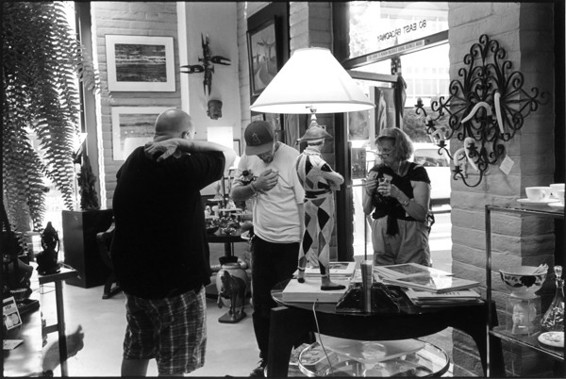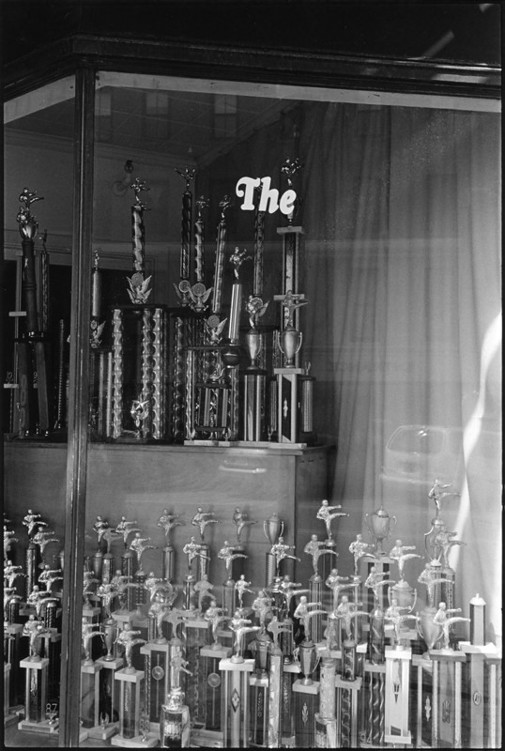Guest Gallery: Blake Andrews, Eugene, Oregon

Blake Andrews is a self-taught photographer based in Eugene, Oregon.
How did you first get started in street photography?
I didn’t start out as a street photographer. In the beginning (circa 1993), I had no idea what street photography was. I just knew I liked to walk around and find pictures, so that’s what I did. I was living in a city at the time, so most of what I was shooting was urban material: signs, graffiti, shadows, clusters of buildings, and so on. I didn’t know any other photographers at the time, and it was before the Internet, so for the first several years I was pretty much on my own. Most days I’d spend some time shooting, then once a week I’d go to the darkroom to see what I’d gotten that week—a pattern I have continued ever since. I occasionally saw photo shows, but I encountered most other photography in books. I was very influenced by [Henri] Cartier-Bresson in the beginning and, later on, [Lee] Friedlander. Those guys helped lay the foundation for me, and even today I find it hard to escape their influence. Cartier-Bresson was a master of visual geometry. From Friedlander I learned the art of layering, and he also showed me that it was okay to inject humor into my photos. Honestly I’m not sure if what I do is street photography. I just follow my muse. Sometimes this leads me to typical urban street situations, and sometimes not. The one thing I shoot more now than I did initially is people, mainly because they’re often the most dynamic elements around. You can walk down the same street over and over and not much changes, except for the people. They’re always different, even from one second to the next. This keeps things fresh.

What are some things you look for when shooting on the street?
I look mostly for form, geometry, pattern. Those are the things that catch my eye initially, and sometimes I wait around to combine them with chance events. Unlike some street photographers, I don’t have much empathy for strangers. My photos don’t usually get inside people’s heads, and they don’t usually have much emotional resonance. I’m more of a cold-blooded assassin. I don’t care who or what is in the photo as long as the elements combine into something visually interesting. I’m very tuned in to gesture, especially hands. I think the two body parts that can make or break any photograph are hands and eyes. But I’m too slow and shy to pay attention to eyes, so for me it’s hands. If I see someone’s hands in an interesting position, it’s almost as if nothing else exists. I zero in and shoot them, and sometimes I’m not even sure what else was in the photo until I see the result. Form and pattern are my building blocks. But the main ingredient in the best street photos is serendipity, and that’s something you can’t really look for. When you look for it, it disappears. But if you shoot enough you can count on it periodically.

Describe the story behind the most meaningful street photograph you have ever taken
It’s impossible to say which one is the most meaningful, but there is one that sticks in my mind: a photo of a woman in front of a bush. This was sort of a turning point for me. The funny thing is, I don’t remember taking that specific image, although I’ve since pinpointed where it must’ve been taken. I was shooting a ton back then, too much to keep track of, really, and this was just one frame on the roll. But when I saw it on the contact sheet it just jumped out at me and I couldn’t wait to print it. The image had a certain quality that I hadn’t noticed before in my work. It was visually confusing, and something about that confusion just pushed a button for me and seemed to offer a new direction. Before that point I’d been trying to document people and events, but this photo wasn’t about the person or the scene so much as it was about raw visual language. It was about the photo itself. I was so excited at the time that I wrote on the back of the work print, “This is the photo I’ve been trying to make!” I’d never written anything on a print before, except for the date and place. But that one seemed special at the time and, almost a decade later, I still like it.

What do you think makes a great street photograph?
There is no one all-purpose formula, but what I enjoy the most are photos that surprise me or make me see things in new and different ways. I enjoy photos that are visually ambiguous, that create a mental puzzle for me to solve and, hopefully, a psychological or social one, too. It goes without saying that a good photo has to have good visual balance. The forms need to relate to one another and also to the frame, and sometimes that relationship can be pleasantly counter-intuitive or off-balance. But beyond form, I think a good photo has to take you someplace past the purely visual, to make you wonder about the scene, and to make you wonder about the world. A lot of times, but not always, this wonder is added through chance element or serendipity. I think it’s hard for any single image to convey the personality of a photographer, but groups of photos can do that. And I think that is what makes most good street photos succeed: when you look at a collection and feel the presence of the person making them.

What advice would you give to aspiring street photographers?
Advice is tough to give. It’s like advising a flower on how to grow. You can talk as much as you want to a flower, but in the end, the thing is going to bloom according to its own design and its own schedule. The worst thing you can do is try to steer it. A rose can’t become a carnation. You just have to have faith that in the end, your flower will bloom. If I have any advice it’s to keep that faith. Don’t short circuit nature. Don’t give up on your style. If you stick with it, and give it attention and food and water, your flower will bloom, and it won’t look quite like any other flower in the world. Don’t shoot street photos. That’s telling the flower how to grow. Instead, shoot whatever interests you regardless of what’s in it or how it looks, or if you think it’s “street” or not. You need to find your interest, find what you see that’s different, and then trust fate.
To learn more about Blake Andrews, and see more of his pictures, point your web browser to blakeandrews.blogspot.com.